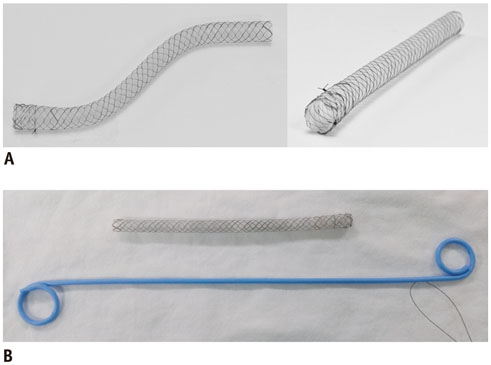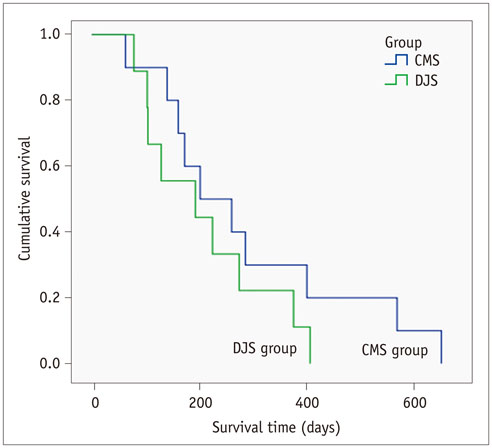Korean J Radiol.
2018 Aug;19(4):606-612. 10.3348/kjr.2018.19.4.606.
A Prospective Randomized Comparison of a Covered Metallic Ureteral Stent and a Double-J Stent for Malignant Ureteral Obstruction
- Affiliations
-
- 1Department of Radiology and Research Institute of Radiology, University of Ulsan College of Medicine, Asan Medical Center, Seoul 05505, Korea. jhshin@amc.seoul.kr
- 2Department of Urology, University of Ulsan College of Medicine, Asan Medical Center, Seoul 05505, Korea.
- 3Department of Oncology, University of Ulsan College of Medicine, Asan Medical Center, Seoul 05505, Korea.
- KMID: 2413690
- DOI: http://doi.org/10.3348/kjr.2018.19.4.606
Abstract
OBJECTIVE
To compare the safety and efficacy between a covered metallic ureteral stent (CMS) and a double-J ureteral stent (DJS) for the treatment of a malignant ureteral obstruction (MUO).
MATERIALS AND METHODS
Nineteen patients (seven men and 12 women; mean age, 53.4 years) were randomly assigned to the CMS (n = 10) or DJS (n = 9) group. The following were compared between the two groups: technical success, i.e., successful stent placement into desired locations; stent malfunction; stent patency, i.e., no obstruction and no additional intervention; complications; and patient survival.
RESULTS
The technical success rate was 100% in all 10 and 12 ureteral units in the CMS and DJS groups, respectively. During the mean follow-up period of 253.9 days (range, 63-655 days), stent malfunction was observed in 40.0% (4/10) and 66.7% (8/12) in the CMS and DJS groups, respectively. In the per-ureteral analysis, the median patency time was 239.0 days and 80.0 days in the CMS and DJS groups, respectively. The CMS group yielded higher patency rates compared with the DJS group at three months (90% vs. 35%) and at six months (57% vs. 21%). The overall patency rates were significantly higher in the CMS group (p = 0.041). Complications included the migration of two metallic stents in one patient in the CMS group, which were removed in a retrograde manner. The two patient groups did not differ significantly regarding their overall survival rates (p = 0.286).
CONCLUSION
Covered metallic ureteral stent may be effective for MUO.
Keyword
MeSH Terms
Figure
Cited by 1 articles
-
Recent Advances in Ureteral Stents
Chan Park, Ji Hoon Shin
J Korean Soc Radiol. 2019;80(4):631-642. doi: 10.3348/jksr.2019.80.4.631.
Reference
-
1. Better OS, Arieff AI, Massry SG, Kleeman CR, Maxwell MH. Studies on renal function after relief of complete unilateral ureteral obstruction of three months' duration in man. Am J Med. 1973; 54:234–240.
Article2. Russo P. Urologic emergencies in the cancer patient. Semin Oncol. 2000; 27:284–298.3. Farrell TA, Hicks ME. A review of radiologically guided percutaneous nephrostomies in 303 patients. J Vasc Interv Radiol. 1997; 8:769–774.
Article4. Radecka E, Magnusson A. Complications associated with percutaneous nephrostomies. A retrospective study. Acta Radiol. 2004; 45:184–188.
Article5. Saltzman B. Ureteral stents. Indications, variations, and complications. Urol Clin North Am. 1988; 15:481–491.6. Chung SY, Stein RJ, Landsittel D, Davies BJ, Cuellar DC, Hrebinko RL, et al. 15-year experience with the management of extrinsic ureteral obstruction with indwelling ureteral stents. J Urol. 2004; 172:592–595.
Article7. Docimo SG, Dewolf WC. High failure rate of indwelling ureteral stents in patients with extrinsic obstruction: experience at 2 institutions. J Urol. 1989; 142(2 Pt 1):277–279.
Article8. Lang EK, Winer AG, Abbey-Mensah G, Anne R, Allaei A, Friedman F, et al. Long-term results of metallic stents for malignant ureteral obstruction in advanced cervical carcinoma. J Endourol. 2013; 27:646–651.
Article9. Wang HJ, Lee TY, Luo HL, Chen CH, Shen YC, Chuang YC, et al. Application of resonance metallic stents for ureteral obstruction. BJU Int. 2011; 108:428–432.
Article10. Kim JH, Song K, Jo MK, Park JW. Palliative care of malignant ureteral obstruction with polytetrafluoroethylene membrane-covered self-expandable metallic stents: initial experience. Korean J Urol. 2012; 53:625–631.
Article11. Trueba Arguiñarena FJ, Fernández del Busto E. Self-expanding polytetrafluoroethylene covered nitinol stents for the treatment of ureteral stenosis: preliminary report. J Urol. 2004; 172:620–623.12. Pollak JS, Rosenblatt MM, Egglin TK, Dickey KW, Glickman M. Treatment of ureteral obstructions with the Wallstent endoprosthesis: preliminary results. J Vasc Interv Radiol. 1995; 6:417–425.
Article13. Chung HH, Lee SH, Cho SB, Park HS, Kim YS, Kang BC, et al. Comparison of a new polytetrafluoroethylene-covered metallic stent to a noncovered stent in canine ureters. Cardiovasc Intervent Radiol. 2008; 31:619–628.
Article14. Chung KJ, Park BH, Park B, Lee JH, Kim WJ, Baek M, et al. Efficacy and safety of a novel, double-layered, coated, self-expandable metallic mesh stent (Uventa™) in malignant ureteral obstructions. J Endourol. 2013; 27:930–935.
Article15. Kim KS, Choi S, Choi YS, Bae WJ, Hong SH, Lee JY, et al. Comparison of efficacy and safety between a segmental thermo-expandable metal alloy spiral stent (Memokath 051) and a self-expandable covered metallic stent (UVENTA) in the management of ureteral obstructions. J Laparoendosc Adv Surg Tech A. 2014; 24:550–555.
Article16. Kim KH, Cho KS, Ham WS, Hong SJ, Han KS. Early application of permanent metallic mesh stent in substitution for temporary polymeric ureteral stent reduces unnecessary ureteral procedures in patients with malignant ureteral obstruction. Urology. 2015; 86:459–464.
Article17. Chung HH, Kim MD, Won JY, Won JH, Cho SB, Seo TS, et al. Multicenter experience of the newly designed covered metallic ureteral stent for malignant ureteral occlusion: comparison with double J stent insertion. Cardiovasc Intervent Radiol. 2014; 37:463–470.
Article18. Chow PM, Chiang IN, Chen CY, Huang KH, Hsu JS, Wang SM, et al. Malignant Ureteral Obstruction: Functional Duration of Metallic versus Polymeric Ureteral Stents. PLoS One. 2015; 10:e0135566.
Article19. Sacks D, McClenny TE, Cardella JF, Lewis CA. Society of Interventional Radiology clinical practice guidelines. J Vasc Interv Radiol. 2003; 14(9 Pt 2):S199–S202.
Article20. Denstedt JD, Wollin TA, Reid G. Biomaterials used in urology: current issues of biocompatibility, infection, and encrustation. J Endourol. 1998; 12:493–500.
Article21. Liatsikos EN, Karnabatidis D, Katsanos K, Kallidonis P, Katsakiori P, Kagadis GC, et al. Ureteral metal stents: 10-year experience with malignant ureteral obstruction treatment. J Urol. 2009; 182:2613–2617.
Article22. Barbalias GA, Liatsikos EN, Kalogeropoulou C, Karnabatidis D, Zabakis P, Athanasopoulos A, et al. Externally coated ureteral metallic stents: an unfavorable clinical experience. Eur Urol. 2002; 42:276–280.
Article23. Kim M, Hong B, Park HK. Long-term outcomes of double-layered polytetrafluoroethylene membrane-covered self-expandable segmental metallic stents (Uventa) in patients with chronic ureteral obstructions: is it really safe? J Endourol. 2016; 30:1339–1346.
Article
- Full Text Links
- Actions
-
Cited
- CITED
-
- Close
- Share
- Similar articles
-
- Recent Advances in Ureteral Stents
- Proximal Migration of Ureteral Stent after Extracorporeal Shock Wave Lithotripsy
- Palliative Care of Malignant Ureteral Obstruction with Polytetrafluoroethylene Membrane-Covered Self-Expandable Metallic Stents: Initial Experience
- Percutaneous ureteral stent insertion
- Adverse Effects of Ureteral Stent and Development of the Antireflux Ureteral Stent





